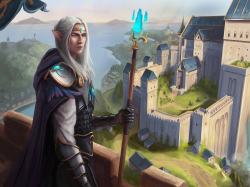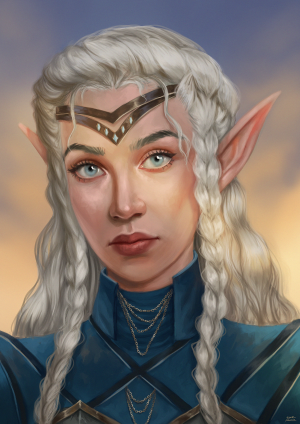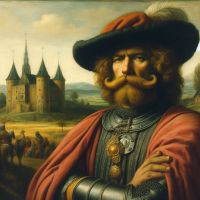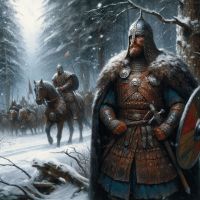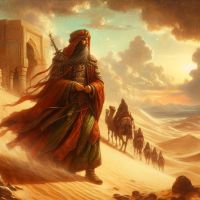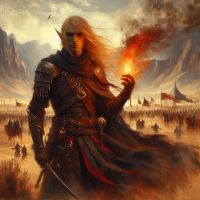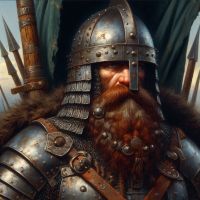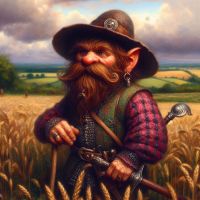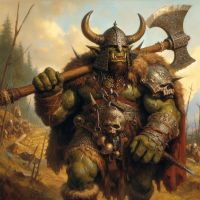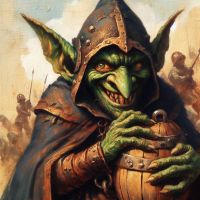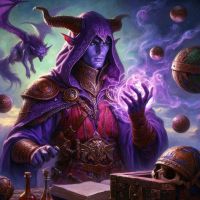High Elves: Difference between revisions
(fixed the height convertion from meters to feet) |
Littlebuggie (talk | contribs) |
||
| Line 9: | Line 9: | ||
|Average Height = 1.87m - 2.20m (6’2" - 7’3") | |Average Height = 1.87m - 2.20m (6’2" - 7’3") | ||
|Average Weight = 75kg to 90kg (165lbs - 198lbs) | |Average Weight = 75kg to 90kg (165lbs - 198lbs) | ||
|Maximum Age = ~ | |Maximum Age = ~450 Years Old | ||
|STR = +0 | |STR = +0 | ||
|DEF = +0 | |DEF = +0 | ||
| Line 38: | Line 38: | ||
nations is known as the Stargazer Calendar and is based on the position of Eseron in the great void towards the sun. An Azari year counts four seasons and ends when Eseron has come full circle around the sun. Besides this elven calendar, the Azari use something known as the Imperial, or common calendar. This calendar developed in the ancient Attian Empire is these days used around the continent and is built to better reflect the lifespan of most other intelligent races and creatures. This calendar runs significantly quicker at four years per single Elven year. The Imperial calendar uses the changing of the seasons as the start of a new year. Making it so that seasons in the Imperial calendar system last for the entire year. | nations is known as the Stargazer Calendar and is based on the position of Eseron in the great void towards the sun. An Azari year counts four seasons and ends when Eseron has come full circle around the sun. Besides this elven calendar, the Azari use something known as the Imperial, or common calendar. This calendar developed in the ancient Attian Empire is these days used around the continent and is built to better reflect the lifespan of most other intelligent races and creatures. This calendar runs significantly quicker at four years per single Elven year. The Imperial calendar uses the changing of the seasons as the start of a new year. Making it so that seasons in the Imperial calendar system last for the entire year. | ||
While the Azari’cill do count in common years, it is not unheard of to hear a particularly conservative Azari’cill still using Elven years and refusing to recognize the imperial system as a valid alternative. The most common place to find active usage of the Elven Calendar is the academic scene. Most Elves prefer to use common years for more mundane things like counting their age or to refer to calendar years. Elves reach adulthood at 72 common years and can live up to 400- | While the Azari’cill do count in common years, it is not unheard of to hear a particularly conservative Azari’cill still using Elven years and refusing to recognize the imperial system as a valid alternative. The most common place to find active usage of the Elven Calendar is the academic scene. Most Elves prefer to use common years for more mundane things like counting their age or to refer to calendar years. Elves reach adulthood at 72 common years and can live up to 400-450 common years. The Azari'cill keep their youthful appearance for most of their lives, only | ||
starting to show visible aging when they reach the age of 350. | starting to show visible aging when they reach the age of 350. | ||
Revision as of 02:12, 6 August 2024
| Azari'cill (High Elves) | |
|---|---|
| Pronunciation | Azaa-rie sill |
| Classification | Elf |
| Nicknames | Anypsóste (The Exalted)
Azari’Lefká (White Elves) |
| Languages | Common, Azari Linguae |
| Average Height | 1.87m - 2.20m (6’2" - 7’3") |
| Average Weight | 75kg to 90kg (165lbs - 198lbs) |
| Maximum Age | ~450 Years Old |
| Stat Bonuses |
+0 Strength +0 Defense +0 Agility +4 Intelligence |
Introduction
As the Azari’cill call themselves, the Scions of Illumination invoke this name because their existence reflects the pinnacle of civilization under the Mother’s watchful gaze.
These luminous beings have blood that glimmers by magical properties. The glittering spires of the Azari cities stand like beacons in the lands where skill and enlightenment saturate the very air. The Azari’cill absorbed so much of this innate potential that when at war, it is said that the phalanxes of the Azari warhosts glow with robust power. An assault by an Azari’cill army is swift and carried out with flawless precision. The enemy is met with a forest of blades and a tidal wave of arcane wrath.
This claim of mastery also carries a deadly arrogance. The Azari'cill come in glory, but they hail from a broken land, their elegant spires toppled and their statuary crumbled into the dust of a dead empire. The stories tell that it was the scourge of Fineall that ravaged the lands of silver; it was unavoidable. The age of the fallen spires has turned the empire of enlightenment into a spell-haunted ruin.
Ever since the Time of Reinvention, the Azari’cill have managed to make peace with the lands they call home.
| “High Elves? Yes, I have seen them from afar once when I made my way over the spine, wandering through their crystal cities. At first, I thought I was seeing ghosts! I saw them moving and they seemed… not normal. It was like a blur of puppets that were moved by an expert puppeteer, so coordinated! Never do they move unless they really have to. Very interesting folk for certain.”
- Catraca Goldnail, Halfling merchant from Mapledale |
Character Creation
Appearance
The High Elves, or Azari’cill as they like to call themselves, are tall, fair-skinned people that mainly reside on the eastern plains of Eden commonly known as Arda or The Glade of Dragons. The average High Elven male can grow up to an average of 2 meters tall. Females tend to be a little shorter, coming in at an average of 1,85 meters. They have blonde or silver hair, yet none of them can grow any facial hair. The Azari’cill commonly has blue or green eyes. Some recorded cases speak of High Elves having silver eyes, however, those are extremely rare cases, in which the ‘cill individual is seen as personally blessed by the Mother, the ‘cill’s patron Goddess. The most distinguishing feature of an Elf is a pair of long ears with a pointed tip. Elven ears can grow up to an average of 15 centimeters.
The Azari live significantly longer than the other races on Eden. Understanding the aging of the Azari can be complicated because they work with two calendars. The official one in most Azari
nations is known as the Stargazer Calendar and is based on the position of Eseron in the great void towards the sun. An Azari year counts four seasons and ends when Eseron has come full circle around the sun. Besides this elven calendar, the Azari use something known as the Imperial, or common calendar. This calendar developed in the ancient Attian Empire is these days used around the continent and is built to better reflect the lifespan of most other intelligent races and creatures. This calendar runs significantly quicker at four years per single Elven year. The Imperial calendar uses the changing of the seasons as the start of a new year. Making it so that seasons in the Imperial calendar system last for the entire year.
While the Azari’cill do count in common years, it is not unheard of to hear a particularly conservative Azari’cill still using Elven years and refusing to recognize the imperial system as a valid alternative. The most common place to find active usage of the Elven Calendar is the academic scene. Most Elves prefer to use common years for more mundane things like counting their age or to refer to calendar years. Elves reach adulthood at 72 common years and can live up to 400-450 common years. The Azari'cill keep their youthful appearance for most of their lives, only
starting to show visible aging when they reach the age of 350.
Language
Elves generally speak the common tongue. This language, through its extreme popularity, has been adopted and normalized in Elven culture. A dialect has sprung up in Aerial from a combination of Ancient Elvish and the common tongue. The ancient elven language is a mostly forgotten one. Scholars in Luminion are trying to rediscover their ancient language and bring it back to the vocabulary of the Elves. “Cilus” is a word without a specified meaning. When someone bears a title with the word “Cilus” in it, it is generally seen as a high-ranking individual.
Often used ancient elven words that found their way into common speech:
| Azari Linguae: Quick Guide | |||||
|---|---|---|---|---|---|
| Greetings | Races | Titles | |||
| Elvish | Common | Elvish | Common | Elvish | Common |
| Vale | Hello/Greetings | Azari | Elf | Therri’cill | Guardian of Purity/King |
| Vale’tar | Farewell | Azari’cill | High Elf/Pure Elf | Aeri’cill | Mother of Purity/Queen |
| Fílo(s) | Friend(s) | Azari’cerr | Wood Elf/Wild Elf | Pricecilus | Prince |
| Azari’lunn | Dark Elf/Moon Elf | Pricecili | Princess | ||
| Azari’soll | Fire Elf/Sun Elf | Nobicilus | Noble | ||
| Dur’arum | Denur | Visera | Minister | ||
| Vari(s) | Human(s) | Ar’mágoi | Arch-Mage/Spellcaster | ||
| Ghesiri(s) | Faulskins(s) | mágoi | Mage/Spellcaster | ||
| De’nevir | Tiefling | Scinar(i)’cilus | High Priest(ess) | ||
| Scinari | Priestess | ||||
| Scinar | Priest | ||||
| Scini | (Older) Student | ||||
| Scin | (Young) Student | ||||
| Bessi’inn | Blessed one | ||||
| Medi’cilus | Doctor/Medic | ||||
Naming Schemes
Elven names, particularly the ones of High Elves are a complex almost unpronounceable mash of sounds to outsiders. Yet do not be fooled by the seeming lack of any structure to Elf names, for they are incredibly valuable to an elven family and mostly of all of massive political importance. Elven family names are all written in the ancient Elven tongue, the Azari Linguae, a mostly unused language lost to time but kept alive by Elves of the Glade in order to keep some semblance of their glorious past alive. It has many different dialects and relies on more than simple syllables to convey meaning.
Elven surnames are the most important part of an elven name, for not only is it a distinguishable trait that comes with a certain amount of prestige, but it is also used as a way to reward Elves of great renown by granting them the right to form a branch of a greater family. For surnames hold only as much value as the power it grants them and adoptions and the forming of new families and branches are common to wash away stains from traitorous names or to profit from the prestige of a greater name. To any High Elf, the greatest punishment is to bring shame to their surname because of the damage it can do to the greater branch. Examples of High Elven family names are; Zaithrall (main branch) and Zaithrec, (granted branch). High Elven families are thus more than a bloodline connection but above all a political tool. Age and deeds contribute the most to the status of a family name and its value in Elven politics.
| Examples of High Elven surnames: Zaithrall, Aey’flir, Eidrith, Illysar, Aedaere, Celephin’nel, Araloth, Vithalion’dir. |
High Elven forenames just like surnames are written in Azari Linguae. They hold far less prestige and are nothing more than what a forename means to most other peoples. High Elven names are very sleek and elegant in the way they are written and spoken, emitting a sort of radiance from them that can only be comprehended and understood by the Elves who more than earned the prestige.
| Examples of High Elven forenames: Aeden, Aldir’tor, Avellorisas, Arathalle, Baruidl, Circya, Cirlia, Deralac, Eldarain, Erethond, Fynenar, Galag, Ilona, Korhian, Maeron, Tetheris, Tharhindrel, Tilly, Veraunn, Zaathos, Zubaran. |
Cultures
Nations and cultures in which the High Elven race is present sorted by dominance.
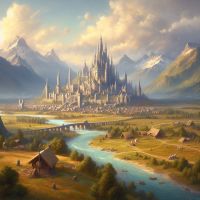
|
The Enlightened Kingdom of Luminion | The Scions of Illumination, as the Azari’cill call themselves, invoke this name because their existence reflects the pinnacle of civilization under the Mother’s wing. These luminous beings have blood that glimmers by magical properties. The glittering spires of the Azari cities stand like beacons in the lands where skill and enlightenment saturate the very air. The Azari’cill absorbed so much of this innate potential that when at war, it is said that the phalanxes of the Azari warhosts glow with robust power. An assault by an Azari’cill army is swift and carried out with flawless precision. The enemy is met with a forest of blades and barrages of elemental wrath. This claim of mastery also carries a deadly arrogance. The Azari come in glory, but they hail from a broken land, their elegant spires toppled and their statuary crumbled into the dust of a dead empire. The stories tell that it was the scourge of Fineall that ravaged the lands of silver; it was unavoidable. The age of the fallen spires has turned the empire of enlightenment into a spell-haunted ruin. Ever since the Time of Reinvention, the Azari’cill have managed to make peace with the lands they call home. |
|---|---|---|
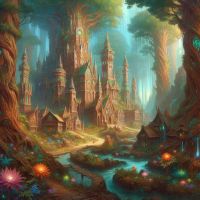
|
The Woodland Realm of Mitrona | Even the bravest of warriors have learned to fear the vast tracts of woodland that can be found throughout the realms of Eden. Surrounded by trees, it is all too easy to get disoriented and lost, but there is a more primal dread at work. In the forest, no one can ever be sure what is lurking just out of sight. Sounds are muffled, yet noises seem to come from everywhere – the snapping of twigs, a sinister rustling of leaves, and the creaking of the wind-stirred canopy above. Nowhere to hide, nowhere to run. Nothing to hear you besides the elemental wrath of the Azari’cerr. These people are highly-skilled elves with centuries of experience in their home environment, the forest. Once an outsider enters Myln Arbor - The mystical forest most of these people call home - it is unlikely he will leave in one piece. |
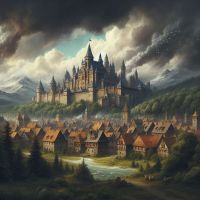
|
The Hadrian Empire | The Hadrian Empire, often referred to as simply ‘the Empire’, is the far-stretching country west of Eden’s Spine. A land inhabited mainly by the dutiful folk that are the Attian humans, one can see the many fields that cover the landscape being toiled by its hard-working citizens. Its cities are often bustling with life, places where trade, commerce, and politics take the main stage. The Hadrian way of life is deeply rooted in tradition and is often relatively simple, mainly because of this the Hadrians are known for their versatility and perseverance through hardship. The civil wars that have plagued the country in the past have left their scars, yet it seems Hadrians always find their way back, dedicating such feats to their deity; Alder. Within the Empire, the political and the martial often go hand in hand, with a large focus on retaining order and stability through military force. Within the Empire, it is not uncommon to see commoners rise through the ranks, oftentimes talented men and women are recognised and get the chance to prove themselves useful to their nation in places such as the army or civil offices. A land full of chance, and one of recognition, with its Kaiser at the helm. |
World View
Character Traits
Upon creation of a High Elf character, you can pick two of the following traits for your character to reflect their background.
| Racial Traits - High Elves | |
|---|---|
| Swift | Players with this trait have +2 movement in CRP. Outside CRP, players with this trait get a permanent speed 1 boost. |
| Arcane initiate | Players with this trait know the "Flame Arrow" spell without needing to be a spellcaster |
| Intelligent | Players with this trait get two extra points in intelligence. |
| Nightseer | Players with this trait get the night vision effect when entering dark spaces and during the night. |
| Dragon Blooded | Players with this trait know the "Breath of the Dragon" spell without needing to be a spellcaster |
| Phalanx | Players with this trait may use the action "form Phalanx" in combat. When they do, they provide a +1 to defensive rolls for everyone and themself within 1 block of them until their next |
| Swift learner | Players with this trait require one less lesson/rp session per magic level before they may do their next bonding trial. |
| Knowledgeable | Players with this trait get two extra lvl 1 spell slots and one extra lvl 2 spell slot. |
| Races | |
|---|---|
| Human Races | Attians · Khadans · Hinterlanders |
| Elvish Races | High Elves · Wood Elves · Dark Elves |
| Dwarvish Races | Denur · Halflings |
| Orcish Races | Orcs · Goblins |
| Other Races | Sylvani · Tieflings |
